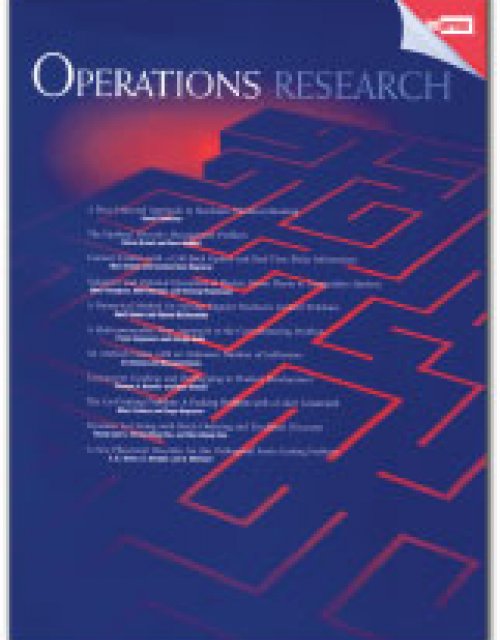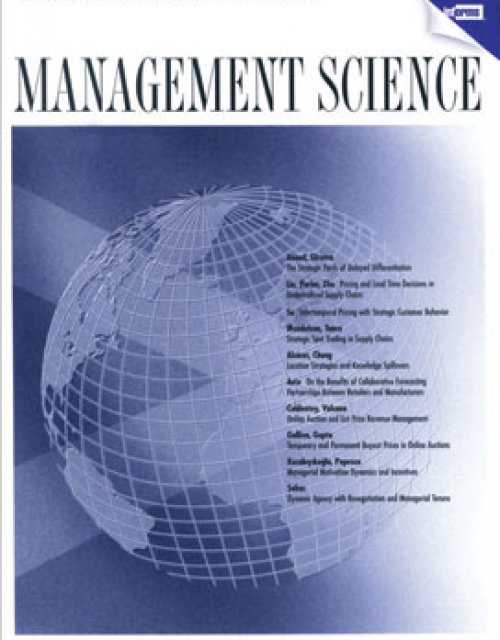Publication records
Subject(s)
Economics, politics and business environment
Keyword(s)
Retail competition, externalities, free-riding, vertical restraints, cross-channel shopping, competition law
JEL Code(s)
K21, L42, L81
Volume
4
Journal Pages
42–83
Subject(s)
Management sciences, decision sciences and quantitative methods; Product and operations management
Keyword(s)
Dynamic mechanism design, optimal control, asymmetric information, environmental regulation, voluntary disclosure
This paper studies the design of voluntary disclosure regulations for a firm that faces a stochastic environmental hazard. The occurrence of such a hazard is known only to the firm. The regulator, if finding a hazard, collects a fine and mandates the firm to perform costly remediation that reduces the environmental damage. The regulator may inspect the firm at any time to uncover the hazard. However, because inspections are costly, the regulator also offers a reward to the firm for voluntarily disclosing the hazard. The reward corresponds to either a subsidy or a reduced fine, depending on whether it is positive or negative. Thus, the regulator needs to dynamically determine the reward and inspection policy that minimizes expected societal cost in the long run. We model this problem as a dynamic adverse selection problem with costly state verification in continuous time. Despite the complexity and generality of this setup, we show that the optimal regulation policy follows a very simple cyclic structure, which we fully characterize in closed form. Specifically, the regulator runs scheduled inspections periodically. After each inspection, the reward level decreases over time until a subsequent inspection takes place. If a hazard is not revealed, the reward level is reset to a high level, restarting the cycle. In contrast to the reward level, the mandated remediation level is constant over time. Nonetheless, when subsidies are not allowed in the industry, we show that the regulator should dynamically adjust this remediation level, which then acts as a substitute for a subsidy. Our analysis further reveals that optimal inspection frequency increases not only when the inspection accuracy decreases, but also when the penalty for not disclosing the hazard increases.
© 2016 INFORMS
Volume
64
Journal Pages
371–389
Subject(s)
Product and operations management
Keyword(s)
Reusability, reuse, innovation, Markov decision process
Many industries, including consumer electronics and telecommunications equipment, are characterized with
short product life-cycles, constant technological innovations, rapid product introductions, and fast obsolescence. Firms in such industries need to make frequent design changes to incorporate innovations, and the
effort to keep up with the rate of technological change often leaves little room for the consideration of product
reuse. In this paper, we study the design for reusability and product reuse decisions in the presence of both
a known rate of incremental innovations and a stochastic rate of radical innovations over time. We formulate
this problem as a Markov Decision Process. Our steady-state results confirm the conventional wisdom that a
higher probability of radical innovations would lead to reductions in the firm's investments in reusability as
well as the amount of reuse the firm ends up doing. Interestingly, the design for reusability decreases much
more slowly than the actual reuse. We identify some specific scenarios, however, where there is no tradeoff
between the possibility of radical innovations and the firms reusability and reuse decisions. Based on over
425,000 problem instances generated over the entire range of model parameters, we also provide insights
into the negative impact of radical innovations on firm profits, but show that the environmental impact of
increased radical innovation is not necessarily negative. Our results also have several implications for policy
makers seeking to encourage reuse.
short product life-cycles, constant technological innovations, rapid product introductions, and fast obsolescence. Firms in such industries need to make frequent design changes to incorporate innovations, and the
effort to keep up with the rate of technological change often leaves little room for the consideration of product
reuse. In this paper, we study the design for reusability and product reuse decisions in the presence of both
a known rate of incremental innovations and a stochastic rate of radical innovations over time. We formulate
this problem as a Markov Decision Process. Our steady-state results confirm the conventional wisdom that a
higher probability of radical innovations would lead to reductions in the firm's investments in reusability as
well as the amount of reuse the firm ends up doing. Interestingly, the design for reusability decreases much
more slowly than the actual reuse. We identify some specific scenarios, however, where there is no tradeoff
between the possibility of radical innovations and the firms reusability and reuse decisions. Based on over
425,000 problem instances generated over the entire range of model parameters, we also provide insights
into the negative impact of radical innovations on firm profits, but show that the environmental impact of
increased radical innovation is not necessarily negative. Our results also have several implications for policy
makers seeking to encourage reuse.
View all ESMT Working Papers in the ESMT Working Paper Series here. ESMT Working Papers are also available via SSRN, RePEc, EconStor, and the German National Library (DNB).
Pages
36
ISSN (Print)
1866–3494
Subject(s)
Economics, politics and business environment
Keyword(s)
Rekommunalisierung, Wettbewerbliche Effekte, Deutschland, Mixed oligopoly, Entsorgungswirtschaft
JEL Code(s)
L33, H76, Q53
Diese Studie untersucht Trends in der Rekommunalisierung in der Entsorgungswirtschaft in Deutschland, analysiert mögliche Erklärungsansätze und überprüft diese empirisch. Wir finden Hinweise auf eine Rekommunalisierungsspirale: Kommunalisierung in der Vergangenheit verstärkt die Anreize für Kommunen zur Kommunalisierung in der Zukunft. Dies liegt, so unsere Vermutung, zum einen an „Ausstrahlwirkungen“ von benachbarten Kommunen, zum anderen an der sinkenden kommerziellen Attraktivität privater Angebote in einem schrumpfenden Wettbewerbsmarkt. Damit können von der Option der kommunalen Eigenerstellung wettbewerbliche Effekte ausgehen. Auf Basis der empirischen Ergebnisse schlägt diese Studie einen Test vor, ob Kommunen die Möglichkeit und den Anreiz zur Rekommunalisierung haben, um zu prüfen, ob die Option der kommunalen Eigenerstellung wettbewerbliche Effekte haben kann.
Pages
69
ISSN (Print)
1866–4016
Subject(s)
Marketing
Keyword(s)
Corporate social responsibility, csr, price fairness
JEL Code(s)
M310
Subject(s)
Economics, politics and business environment
Keyword(s)
Labor contracts, incentives, behavioral economics, plantations
JEL Code(s)
D82, D86, J33, J41, J43, O13, Q12
We study a contract change for tea pluckers on an Indian plantation, with a higher government-stipulated baseline wage. Incentive piece rates were lowered or kept unchanged. Yet, in the following month, output increased by 20 to 80 percent. This response contradicts the standard model and several variants, is only partly explicable by greater supervision, and appears to be "behavioral." But in subsequent months, the increase is comprehensively reversed. Though not an unequivocal indictment of "behavioral" models, these findings suggest that nonstandard responses may be ephemeral, and should ideally be tracked over an extended period of time.
Copyright © 2016 by the American Economic Association.
Volume
106
Journal Pages
316–358
Subject(s)
Entrepreneurship
Keyword(s)
Microeconomic behavior, industrial organization, firm objectives, organization and behavior, market structure, firm strategy, market performance, patent system, patent litigation
JEL Code(s)
K11, K41, O34
Postgrant validity challenges at patent offices rely on the private initiative of third parties to correct mistakes made by patent offices. We hypothesize that incentives to bring postgrant validity challenges are reduced when many firms benefit from revocation of a patent and when firms are caught up in patent thickets. Using data on opposition to patents at the European Patent Office we show that opposition decreases in fields in which many others profit from patent revocations. Moreover, in fields with a large number of mutually blocking patents, the incidence of opposition is sharply reduced, particularly among large firms and firms that are caught up directly in patent thickets. These findings indicate that postgrant patent review may not constitute an effective correction device for erroneous patent grants in technologies affected by either patent thickets or highly dispersed patent ownership.
© 2016 INFORMS
Volume
62
Journal Pages
704–721
ISSN (Online)
1526-5501
ISSN (Print)
0025–1909
Subject(s)
Entrepreneurship; Technology, R&D management
Keyword(s)
Patent indicators, patent system, product commercialization, pharmaceutical industry, drug development
Patent-based measures are frequently used as indicators in empirical research on innovation and technological change. Currently, there is little evidence as to what extent patent-based indicators relate to product market outcomes. Using a unique dataset that links outcomes from product commercialization in the pharmaceutical industry with detailed patent data, we relate patent-based indicators that capture either an invention’s value or the uncertainty surrounding the patenting process to the outcomes of the product development process. Our findings suggest that the speed of commercialization increases with value but reduces with uncertainty. Using a variety of alternative indicators we derive implications for the use and the proper interpretation of individual measures. Moreover, our study has broader implications as it highlights the detrimental effect of uncertainty on the speed of innovation.
With permission of Elsevier
Volume
45
Journal Pages
1091–1102
Subject(s)
Economics, politics and business environment
Keyword(s)
distributed energy resources, energy efficiency, energy storage, electric vehicles
Secondary Title
Future of utilities - utilities of the future: How technological innovations in distributed energy resources will reshape the electric power sector
Pages
303–321
ISBN
978-0-12-804249-6
Subject(s)
Strategy and general management
Keyword(s)
Business planning, venture creation, entrepreneurship, start-ups
Zum Werk Businessplanung ist ein essentieller Bestandteil vor, bei und nach der Gründung eines Unternehmens. Selbst nach Etablierung eines Unternehmens sollte ein kontinuierlicher Planungsprozess und damit die Konkretisierung und Quantifizierung von Unternehmenszielen beibehalten werden. Im Mittelpunkt steht die Businessplanung von jungen Unternehmen. Hier ist der Planungsbedarf am größten aber auch zugleich am schwierigsten zu gestalten. Um eine solide Informationsgrundlage für (potenzielle und tatsächliche) Gründer und Jungunternehmer zu haben, werden im vorliegenden Buch die relevanten Bereiche einer adäquaten Geschäftsplanung dargestellt und erläutert. Vorteile auf einen Blick - Schritt für Schritt zum perfekten Businessplan - praxisorientiert und sofort umsetzbar - Tipps für die überzeugende Präsentation vor Investoren und Bankern Zielgruppe Für Existenzgründer und Unternehmer
Volume
3rd ed.,
Pages
180
ISBN
978-3406681080


